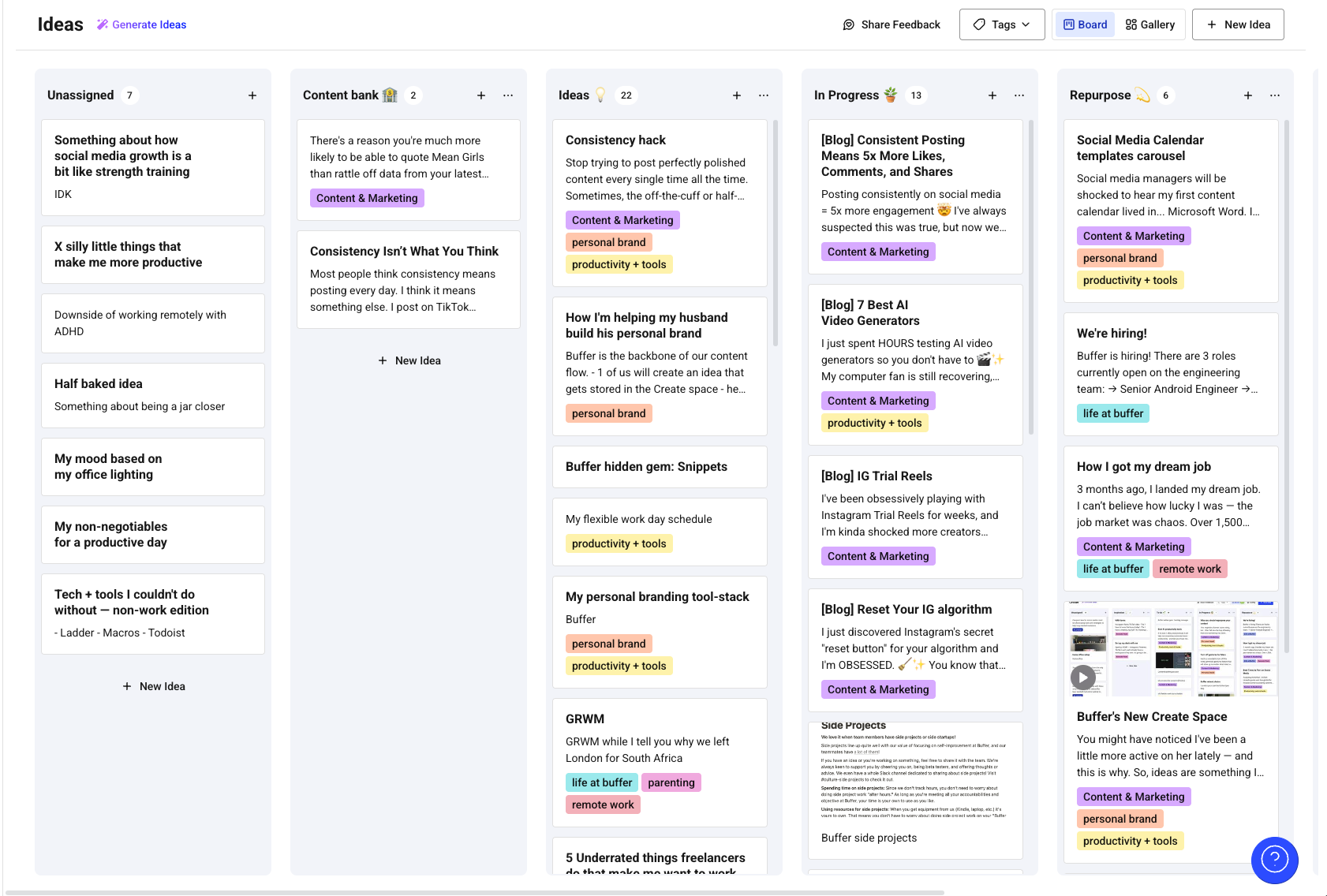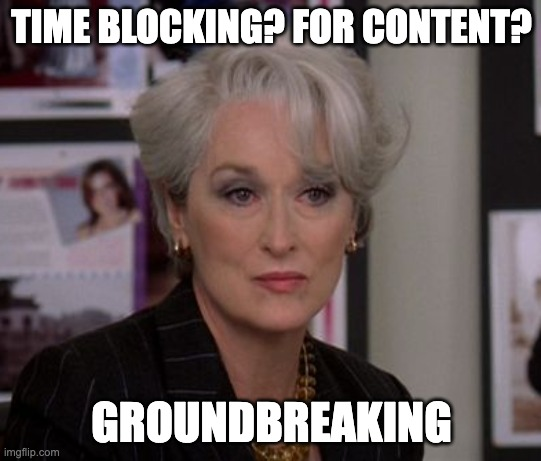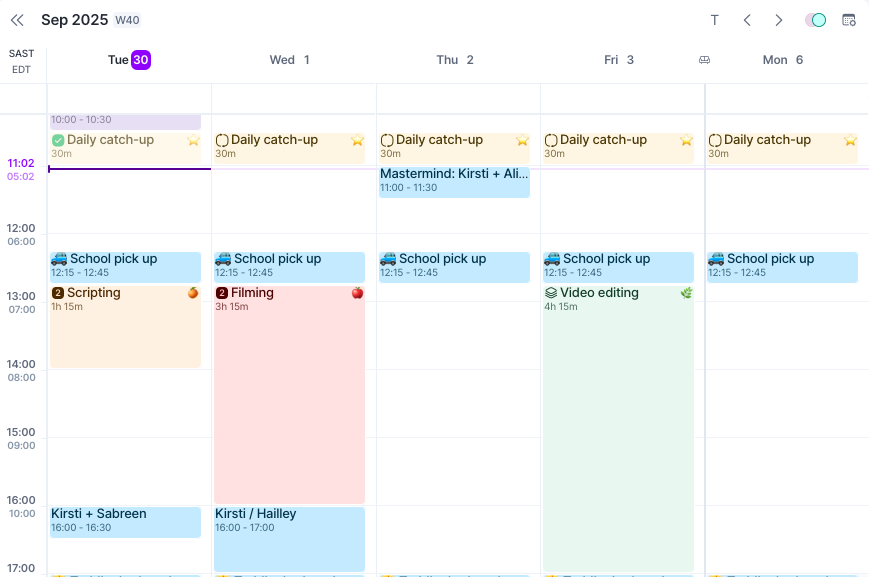I’m a mom with a full-time job, and I’m an active creator. I also have ADHD. That combination of factors can make getting stuff done… complicated.
But with the help of (many) handy systems, tactics, and tools, I feel as though I’ve made juggling all that with my neurodivergent brain a whole lot smoother. It’s certainly not easy, but it’s very, very doable.
I’ve been actively growing an audience on LinkedIn, Instagram, and TikTok for a few years now. I have around 20K followers across all platforms, and I’ve even been able to monetize my work.
Now, consistently creating content when it’s not your full-time gig can take a lot of time, energy, and focus for most folks.
Adding a layer of neurodivergence into the mix can make it a little less straightforward.
I’ve had to build systems that flow with me, rather than trying to squish my excitable ADHD brain into a rigid, run-of-the-mill productivity system.
Before we dig in, a quick note: I’m not a medical professional, and it’s always best to seek help from a pro if you’re really struggling. In fact, I highly recommend it.
Also, this isn’t a groundbreaking productivity masterclass. These tactics help me move from “this is a great content idea — oh, I have to clean the oven — did I remember to send that email?” to actually hitting publish.
If you’re a creator with ADHD, I hope this gives you a few tools to try. Or maybe even the confidence to take the first step.
My (ADHD) origin story
To explain my process, I thought it would be helpful to share more about my special brand of ADHD, too. There really is a spectrum when it comes to the way it presents, and no two ADHDers think or behave the same way.
Like many women, my ADHD flew under the radar for years. I was diagnosed at around 17. It happened when my parents, very keen for me to follow a more traditional career path, took me to a psychiatrist for psychometric testing.
Apart from confirming that, no, I was not a great fit for a career in accounting (thanks, doc), he diagnosed me with ADHD.
I remember him being quite surprised I’d not been diagnosed before — and that I had a pretty good academic record.
At the time, I thought he must have misdiagnosed me. My reference point for ADHD was, like most people’s, the hyperactive boy in primary school who frequently derailed the class.
How could I, the straight-A drama kid who had literally never been sent to detention, have the same thing as him?
Sure, I dealt with focus issues, impulsivity, perfectionism, and hyper-fixations — but don’t all teenage girls?
Well, it’s been (cough) almost 20 years since then, and I’ve learned a lot about my neurodivergence. Most importantly:
- The psychiatrist was right.
- It might be the same on paper, but I don’t really have the same condition as the hyperactive kid in my grade 7 homeroom class. My ADHD, like most women’s, manifests quite differently.
- My academic record — much like working life today — was just fine because I leaned heavily on systems.
(I have a lot to say about #2, but I’m going to put a pin in that for now — that’s not why you clicked on this article, is it? If you want to chat, seriously, come find me on Threads!)
#3 is what I want to get into in this article. The systems I’ve come to recognize and refine over the years have helped me work well in my 9-to-5 (mostly!) and even build and nurture an audience on social media.
Here’s what works for me.
My ADHD-approved creator system
1. ‘Done is better than perfect’
ADHD and perfectionism often go hand in hand.
We see a million ways something could be better, so we keep tinkering… and tinkering… Or we abandon our work completely because it’s not perfect, so what is the point, even?
To avoid spiralling down either of these paths, I live by the mantra, ‘Done is better than perfect.’
That can manifest in real life in many different ways. Sometimes, it means setting a time limit on how long I’ll spend editing a video or rewriting a text post. Other times, it’s hitting “publish” even when I feel like the content is ‘fine’ rather than exceptional.
A huge turning point for me was actually this video by Ali Abdaal about his top tips for starting on YouTube. (I’ve found much of it applies to any sort of content creation.)
I found that my desire for perfection in my content was mostly what people who already knew me were going to think of it — my friends, my family, old classmates. If my content was not perfect, surely they would find me ridiculous? What business did I have being a creator if my content wasn’t as exceptional as, well, someone like Ali?
But Ali spoke directly to this fear of judgment in the video. “No one cares,” he says. “When I started on YouTube, I was afraid people were going to say bad things about it, that people were going to judge me.”
“And then I started making videos, and I realized no one cares. People are busy with their own lives, they are doing their own stuff, they do not give a flying toss whether or not I have a YouTube channel.”
When you really think about it, that’s true. And isn’t it quite freeing?
Another truth that helps me keep that desire for absolute perfection with every post at bay: you’re not going to get better until you get feedback from your audience. That means likes, comments, views, shares — and to get those, you’ve got to hit publish. Perfection isn’t the goal — publishing is.
So, in many ways, chasing perfection actually requires putting things out into the world that aren’t ‘perfect.’
2. Write everything down the second inspiration strikes
Let me tell you something about ADHD folks — we are excellent at coming up with new ideas.
Genius strikes us often, and it’s usually in the oddest of places. My pingpong ball brain tends to be most active in the gym, on walks, while running errands, and cooking dinner.
If I don’t capture those ideas immediately, they’re gone.
That’s where Buffer’s Create Space comes in. I have the app on my phone, and a tab is also open on my desktop browser. I’ve built the habit of getting everything down as soon as it pops into my head.
Here’s a peek at my Create Space in Buffer:

Sometimes it’s a fully fleshed-out concept. Others, it’s a three-word phrase. Either way, it gets a Create Space card, and I’ll come back to it when I have the time to actually sit with it.
Which brings me to my next point.
3. Brain dump now, create later
It’s all very well jotting down ideas as soon as they pop up. But sometimes it’s best just to set them down and walk away.
I find stepping away when inspiration isn’t flowing just as important for ADHDers.
“There’s nothing to writing. All you do is sit down at a typewriter and open a vein,” Ernest Hemingway supposedly once said. (It’s likely a misattributed quote, but I love it anyway.)
This is exactly what it feels like when I try to force creativity. And I don’t want to ‘bleed’ for my content.
In the past, I’ve spent hours on concepts, opening the vein again and again. But it’s a waste of my time when I’m not in the right headspace for it. I’m a pretty time-strapped person and could spend those precious hours elsewhere.
Sure, I don’t have the luxury of being able to do this with all my work, but I always take this approach with my own content. It’s not my full-time work, and I have the space to be flexible there. Trying to force myself into that headspace is a surefire recipe for putting me off creating content completely.
This doesn’t just apply to the moment I save the idea, either. I’ll frequently have time blocked out to create content (more on this below) and sit down to work on a specific idea and… crickets. Sometimes jumping to another post idea works. Sometimes I have to step away entirely.
And that’s absolutely fine.
4. Batch content creation with themed time blocks
I touched on the idea of having content creation time blocked out in my calendar — groundbreaking, I know. But there’s more!

I like to ‘theme’ these blocks, so I’m not jumping between writing, filming, and editing. Switching between tasks is one of the fastest ways for me to lose focus. For example, I’ll end up jumping straight into filming before having properly scripted something, only to realize I didn’t quite say what I meant to say… and have to restart the process from scratch.
So when I’m in “creation mode,” I do one type of content at a time. One time block might be for writing LinkedIn posts. Another = filming videos. Next week’s block = editing.
Here’s a look at how I’ve mapped out some tasks for this week:

4. Use tools to help me stay organized (and get a dopamine hit)
If you’ve spent more than 30 minutes in my company, I’ve no doubt told you about my new favorite productivity tool. I love them, and they are a HUGE reason I’m relatively organized and get stuff done. (Here’s a list of my favorite productivity tools, by the way!)
For me, there are two reasons they work so well.
- They help me clear my brain of all the essential stuff, reducing the feeling of overwhelm and preventing me from forgetting these tasks. My brain is for creativity and problem-solving — it’s not for long-term storage.
- They gamify my productivity.
Let me elaborate. People with ADHD typically have lower levels of dopamine or differences in how dopamine functions in the brain.
Tasks that are boring or repetitive can feel impossibly hard. They don’t trigger enough of a dopamine reward to hold attention — which is where my tool stack comes in.
I test loads of tools, but I’ve found the ones that stick are those that give me a little sense of satisfaction for completing a task. My favorites right now are:
- Todoist: My general catch-all for tasks. Everything from ‘Book dentist’ to ‘Write ADHD creator article’ goes here, first. Todoist has a ‘Karma’ points system, earned when you complete tasks.
- Akiflow: My task consolidator. It connects my work and personal calendars, along with flagged emails, Slack messages, and more. I can color-code absolutely everything, which I find essential for making sense of things.
- Buffer: My content second brain and cheerleader. Along with storing and scheduling all my content, Buffer’s Streaks feature keeps track of how many weeks I’ve shared posts on social media. I’m on week 38 now! And there is absolutely no way I’m going to lose that streak.
5. Use focus timers to get into flow
Speaking of visually appealing tools — have you ever tried a focus timer?
Whether it’s a YouTube video, an app, or even an egg timer, setting a timer for a specific task is a brilliant way to minimize distractions.
I’ve found that using timers like this creates a bit of a boundary to keep me from switching. “I’ve set 45 minutes for this item. The timer is running, I can’t do anything else.”
Of course, my preference is to use apps for this — there are loads of super visually appealing ones that are brilliant at gamifying your work. My favorites right now are:
- Focus Traveller: Turns Pomodoros into a little RPG journey (you literally go on a virtual mountaineering adventure while you work).
- Bento Focus: An app designed explicitly for ADHDers that forces you to reduce your never-ending task list to three items per day. From there, you enter estimated times for each item and start the timer.
My ADHD brain loves novelty and visual feedback, and these apps give me both.
Even a basic timer works if you don’t want the bells and whistles. The key is creating a container for deep focus. It’s a reminder that you don’t need to do everything at once.
6. I have a working environment set for my senses
Working in a calm, clean environment is a non-negotiable for me to get anything done. I learned early on in my ADHD journey that having space like this, one dedicated to work, is one of the easiest ways to cue my brain that “this is focus time now.”
When everything around me feels calm and intentional, it helps me lock in.
In recent years (thank you, remote work!) I’ve been able to take this a step further, tapping into specific senses to help me activate ‘work’ mode.
- Sight: The clean, cozy environment.
- Sound: I love lo-fi or ambient sounds on YouTube or the focus music app, brain.fm.
- Smell: I use a diffuser and essential oils in my office that I turn on whenever I need to get into deep focus mode. There’s no science behind which scents I use, though — I’ve chosen a couple of smells I like, and have those on repeat.
- Touch: My mechanical keyboard is the absolute best for creating text-based content. The feedback from the keys, along with the pebbly sound, makes me feel like I’m creating something tangible, rather than just words on a screen.
- Taste: Coffee? (OK, that’s more about the caffeine and less about the sense, but even just the smell of coffee helps!).
7. Separate “creation mode” from “consumption mode”
One of the biggest barriers to actually making content is the social media platforms themselves.
I’ll open TikTok to grab a trending audio, find inspiration for a reel, or actually post content — and suddenly, two hours have passed, and I have nothing to show for my time.
I know this is not a uniquely ADHD thing, though ADHD definitely amplifies it. The dopamine surge of ‘next post, next video’ is tough to pull away from.
To protect my focus, I mentally split my time into “creation mode” and “consumption mode.”
- Creation mode = Happens in Buffer. I don’t even need to open Instagram, LinkedIn, or TikTok to create a post. I can write captions, schedule posts, and review analytics without having to open Instagram or TikTok at all — which means I’m not accidentally getting sucked into the feed when I meant to be productive.
- Consumption mode = This is a free-time activity that I try to be really intentional about. As a creator, this is something I need to do to stay on top of trends and find inspiration, so it’s not something I feel guilty about. But it really helps to go into the scroll with this mindset.
What really helps is using Buffer as a separate space for content creation. It’s a small shift, but it makes a massive difference in how much I actually create vs. just thinking about creating.
The part where I tell you you’re doing just fine
Hey. 👋 From one ADHDer to another — you don’t need to change your brain to be productive and successful.
Whether that’s creating content or something else, the fact that you’re actively trying means you’re doing more than most.
As you can likely tell from all of the above, my ADHD strategy is leaning in rather than fighting against. Creating content with ADHD isn’t about forcing yourself to be hyper-productive or disciplined.
It’s about designing systems that work for how your brain naturally operates — and letting go of the idea that you need to be perfectly consistent, focused, or polished.
I’ve found that a little structure and a lot of self-compassion go a long way.
And if you’re reading this while procrastinating on your next post? Take this as your sign to open up your Create Space and jot something down — even if it’s messy.






